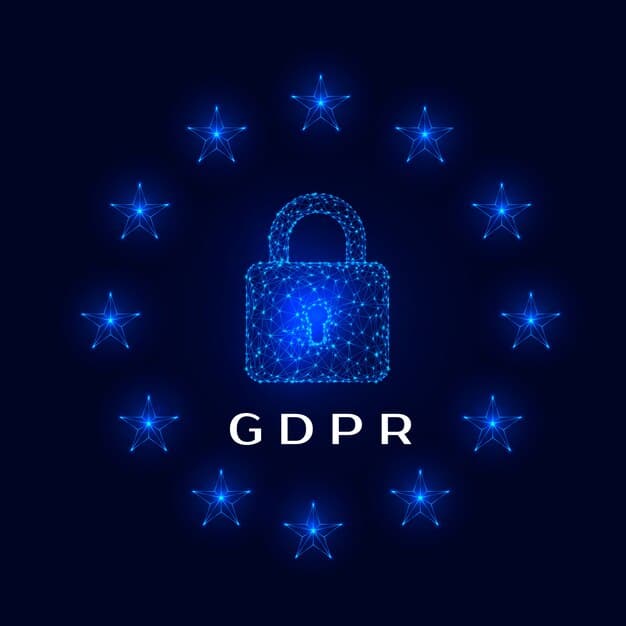Data Security 2025: Compliance with State Breach Laws

Navigating the complex landscape of statewide data breach notification laws in 2025 is crucial for businesses to ensure data security, protect consumer trust, and avoid significant legal and financial penalties, demanding a proactive compliance strategy.
In an increasingly digital world, the threat of data breaches looms larger than ever. For businesses, understanding and adhering to the intricate web of state data breach notification laws is not merely a formality but a fundamental necessity. By 2025, the regulatory environment continues to evolve, making the task of how to Ensure Data Security: Complying with State Data Breach Notification Laws in 2025 a critical challenge that demands unwavering attention and proactive strategies from entrepreneurs and established enterprises alike.
The Evolving Landscape of Data Breach Notification Laws
The regulatory framework surrounding data security is in constant flux, shaped by technological advancements, emerging cyber threats, and shifting public expectations regarding privacy. For businesses, this dynamism means that what was compliant yesterday may not be so tomorrow. Understanding the historical context and the current trajectory of these laws is essential for developing a resilient compliance strategy. These laws typically mandate that organizations notify individuals whose personal information has been compromised, as well as relevant state authorities, within specific timeframes.
The past few years have seen a significant increase in both the frequency and sophistication of cyberattacks. This surge has, in turn, spurred legislative bodies at the state level to enact more stringent and varied data breach notification requirements. While federal guidelines provide a baseline, individual states have often gone further, introducing unique definitions of what constitutes “personal information,” different notification timelines, and varying thresholds for reporting. This patchwork of regulations creates a complex compliance challenge, especially for businesses operating across state lines or handling data from residents of multiple states.
Key Drivers of Legislative Change
Several factors are continuously pushing the evolution of data breach notification laws. Consumer demand for greater transparency and accountability from companies regarding their data handling practices is a primary driver. High-profile data breaches have eroded public trust, leading to increased pressure on lawmakers to act. Technological progress also plays a role, as new data collection and storage methods necessitate updated legal stipulations to cover emerging vulnerabilities.
* Increased frequency and severity of cyberattacks.
* Growing public awareness and demand for data privacy.
* Advancements in data processing and storage technologies.
* Interstate commerce requiring harmonized or distinct regulations.
Furthermore, the desire to prevent future incidents and mitigate the damage from successful attacks motivates legislators to refine existing laws and introduce new ones. This proactive approach often involves learning from past incidents and incorporating best practices into legal requirements. The goal is not just to punish non-compliance but to foster a culture of robust data security within organizations.
The Impact of Emerging Technologies
As businesses adopt new technologies like artificial intelligence (AI), blockchain, and the Internet of Things (IoT), new avenues for data collection and processing emerge. While these technologies offer immense benefits, they also introduce novel data security challenges and potential breach points. Legislators are grappling with how to adapt current laws to encompass these innovations, ensuring that consumer data remains protected even as the technological landscape transforms rapidly. This necessitates ongoing monitoring of legislative proposals and technological trends for any business serious about compliance.
The continuous evolution of data breach notification laws underscores the need for businesses to adopt a proactive and adaptive approach to data security. Staying informed about the latest legal developments and understanding the underlying drivers of these changes is paramount. This foundational understanding allows organizations to predict future requirements and build compliance frameworks that are both robust and flexible, ready to adjust to new mandates as they arise.
Understanding the Core Components of State Data Breach Laws
Navigating the complexities of state data breach notification laws requires a clear understanding of their fundamental components. While specifics vary from state to state, several core elements are consistently present, forming the bedrock of these regulations. Businesses must pay close attention to these details to build an effective compliance framework and respond appropriately should a breach occur. Ignoring any of these components can lead to costly penalties and reputational damage.
At the heart of most state data breach laws is the definition of a “data breach” itself. This definition typically specifies what constitutes a security incident that triggers reporting obligations, often involving the unauthorized access to or acquisition of unencrypted computerized data that compromises the security, confidentiality, or integrity of personal information. The type of data considered “personal information” is also crucial, varying from general identifying details to more sensitive categories like biometric data or health records.
What Constitutes a Data Breach?
A data breach is generally defined as an unauthorized acquisition of computerized data that compromises the security, confidentiality, or integrity of personal information. However, the nuances lie in the specific types of data covered and the circumstances under which notification is required. Many states specify that the data must be “unencrypted” or “unredacted” to trigger notification. Some laws also include a “risk of harm” threshold, meaning notification is only required if the breach poses a reasonable risk of identity theft or other harm to the individual.
The scope of what constitutes an unauthorized acquisition can also be broad, covering everything from external cyberattacks (like hacking or ransomware) to internal incidents resulting from employee negligence or malicious insider activity. Businesses must implement robust monitoring systems to detect various types of potential breaches, regardless of their origin, ensuring timely identification and response.
Key Definitions: Personal Information and Notification Triggers
The definition of personal information is arguably the most critical aspect. While most states include common identifiers like name, address, Social Security number, and driver’s license number, an increasing number are expanding this to include medical information, financial account numbers, biometric data, and even online account credentials. Knowing what specific data types are covered in each state where your business operates is essential for accurate risk assessment and breach management.
* Social Security Number (SSN)
* Driver’s License Number or State ID Card Number
* Financial Account Numbers (e.g., credit/debit card numbers with access code/password)
* Medical Information (e.g., health insurance information, medical records)
* Biometric Data (e.g., fingerprints, facial scans)
* Username/email with password/security question and answer
Notification triggers are also a key component. These typically involve a determination that personal information has been accessed or acquired by an unauthorized person, and that such access or acquisition is likely to result in substantial harm or inconvenience to the affected individuals. Some states have specific thresholds for the number of affected individuals that trigger broader notification requirements, such as reporting to state attorneys general or consumer protection agencies.
Notification Deadlines and Content Requirements
Once a breach is discovered, businesses face stringent notification deadlines. These vary widely, from “without unreasonable delay” to specific timeframes like 30, 45, or 60 days from discovery. Expediency is critical, as delays can lead to increased penalties. The content of the notification letter is also regulated, typically requiring clear information about the breach’s nature, the types of data compromised, actions taken by the organization, and steps individuals can take to protect themselves (e.g., fraud alerts, credit monitoring).
Failure to adhere to these core components can have significant repercussions, including fines, lawsuits, and a loss of customer trust. Therefore, a comprehensive understanding of each state’s specific requirements, coupled with a proactive approach to compliance, is non-negotiable for businesses operating in today’s data-driven economy.
Strategies for Proactive Compliance in 2025
In the dynamic regulatory environment of 2025, a reactive approach to data breach compliance is simply insufficient. Businesses must pivot towards proactive strategies, integrating security and compliance into every facet of their operations. This approach not only ensures adherence to evolving state laws but also builds a stronger, more resilient organization less susceptible to breaches and their damaging aftermath. Proactive compliance is an ongoing journey, not a one-time event, requiring continuous assessment and adaptation.
The foundation of proactive compliance lies in establishing a robust data governance framework. This includes identifying all data collected, processed, and stored, understanding its sensitivity, and mapping its lifecycle. By knowing what data you have and where it resides, you can better protect it and respond effectively in case of an incident. This comprehensive understanding is the starting point for developing tailored security measures and compliance protocols.
Implementing Robust Data Security Measures
The cornerstone of avoiding data breaches is strong security. This involves a multi-layered approach, encompassing technical safeguards, administrative policies, and physical controls. Technical measures should include encryption for data at rest and in transit, multi-factor authentication (MFA), regular vulnerability assessments, and intrusion detection systems. Regular security audits and penetration testing are also vital to identify and address weaknesses before they can be exploited.
* End-to-end data encryption.
* Regular security patches and software updates.
* Employee training on cybersecurity best practices.
* Incident response plan development and testing.
* Vendor risk management programs.
Policies and procedures are equally important. Develop clear guidelines for data access, handling, and disposal. Implement a “least privilege” principle, ensuring employees only have access to the data necessary for their roles. Additionally, establish comprehensive employee training programs, making data security a shared responsibility across the organization. Human error remains a significant factor in many breaches, making education paramount.
Developing a Comprehensive Incident Response Plan
Even with the most robust security measures, breaches can occur. Therefore, a well-defined and regularly tested incident response plan (IRP) is critical. This plan should detail the steps to be taken from breach detection through containment, eradication, recovery, and post-incident analysis. A critical component of the IRP is clearly outlining notification procedures for affected individuals and relevant state authorities, adhering to specific deadlines and content requirements.
Furthermore, businesses should consider engaging legal counsel specializing in data privacy and cybersecurity to assist in IRP development and provide guidance during a live incident. Their expertise can be invaluable in navigating the legal nuances of breach notification laws and minimizing potential liabilities. Regular tabletop exercises and simulations of data breach scenarios help ensure the plan is practical and that all team members understand their roles when a real incident strikes.
By focusing on these proactive strategies, businesses can not only meet their compliance obligations but also enhance their overall security posture, protecting their assets and maintaining vital customer trust in an increasingly volatile digital landscape. This forward-thinking approach minimizes risk and positions the business for long-term health and growth.
The Role of Technology in Ensuring Compliance
As data breach notification laws become increasingly complex, leveraging technology is no longer optional but essential for effective compliance. Modern software solutions and cybersecurity tools can significantly streamline the process of monitoring, detecting, responding to, and reporting data breaches, helping businesses stay ahead of regulatory requirements in 2025. These technological aids enhance both the efficiency and accuracy of compliance efforts, reducing the burden on human resources.
From advanced threat detection systems to automated compliance platforms, technology offers a suite of capabilities that can transform a business’s data security posture. Investing in the right tools can provide real-time insights into potential vulnerabilities, accelerate incident response, and simplify the complex task of multi-state notification, thereby minimizing legal and financial risks.
Automated Breach Detection and Response Tools
Automated tools are at the forefront of modern data security. Intrusion Detection Systems (IDS) and Security Information and Event Management (SIEM) solutions can continuously monitor network traffic and system logs for suspicious activity, alerting security teams to potential breaches as they occur. These systems leverage artificial intelligence and machine learning to analyze vast amounts of data, identifying patterns that might indicate a cyberattack, often long before human analysts could.
Moreover, Security Orchestration, Automation, and Response (SOAR) platforms can automate significant portions of the incident response process. This includes automatically isolating affected systems, blocking malicious IP addresses, and initiating data backups. By reducing the manual effort required in the initial stages of a breach, these tools enable faster containment, minimizing data loss and operational disruption. The speed of response is often critical in adhering to strict notification deadlines.
Compliance Management Platforms
Compliance management platforms are specifically designed to help businesses navigate the labyrinth of state-specific data breach laws. These platforms can track evolving regulations, provide guidance on specific notification requirements for different states, and even automate the generation of compliance reports and notification letters. They often feature centralized dashboards that give a holistic view of a company’s compliance status, highlighting areas that need attention.
* Centralized dashboard for compliance overview.
* Automated tracking of regulatory changes.
* Templates for breach notification letters.
* Workflow management for incident response.
* Reporting tools for regulatory agencies.
Beyond breach notification, these platforms can assist with broader compliance efforts, such as data mapping, consent management, and privacy impact assessments. By providing a single source of truth for all compliance-related activities, they reduce the risk of oversight and ensure that all necessary steps are taken to meet regulatory obligations. Opting for a comprehensive compliance management solution can save significant time and resources, while also enhancing accuracy.
Data Loss Prevention (DLP) Solutions
Data Loss Prevention (DLP) solutions are another critical technology. These tools identify, monitor, and protect sensitive data wherever it resides—on endpoints, in the cloud, or in motion across the network. DLP systems can prevent unauthorized data transfers, block access to sensitive information by unauthorized users, and enforce data handling policies. By proactively preventing data from leaving the organization’s control, DLP significantly reduces the likelihood of a breach occurring in the first place.
Leveraging these advanced technologies not only bolsters a business’s data security but also provides a systematic and efficient way to maintain compliance with the ever-changing landscape of state data breach notification laws. Integrating such tools into your security architecture is a strategic imperative for any business aiming to thrive in the digital economy of 2025.
Navigating Multi-State Compliance Challenges
For businesses operating across state lines or handling data from consumers nationwide, the sheer diversity of state data breach notification laws presents a formidable compliance challenge. The lack of a single, overarching federal standard means that organizations must contend with a patchwork of varying definitions, timelines, and notification requirements, creating a complex web of obligations. Successfully navigating these multi-state compliance challenges requires a meticulous and adaptable approach.
The primary difficulty lies in the nuances: what constitutes “personal information” in one state may differ significantly from another. Similarly, the trigger for notification, the designated recipients (e.g., specific state agencies, credit reporting agencies), and the precise content of the notification letter can vary. This necessitates a detailed, state-by-state analysis for any data breach incident, compounding the complexity and urgency of response.
The Patchwork of State Laws: Key Differences
The discrepancies among state data breach notification laws can be subtle yet critical. Some states, like California (with the CCPA/CPRA) and Virginia (with the VCDPA), have broad definitions of personal information and rights, while others may be more narrowly focused. The timeframe for notification is a significant variable; some states require notification “as expediently as possible” or within 30 days, while others allow up to 60 or even 90 days. These varying deadlines can be particularly challenging when managing a large-scale breach affecting individuals in multiple states.
Moreover, thresholds for reporting to state authorities or consumer reporting agencies also differ. Some states mandate reporting if a certain number of residents are affected (e.g., 500 or 1,000 individuals), while others require reporting regardless of the number. The sheer volume of variations demands that businesses maintain an up-to-date repository of each state’s specific requirements, enabling a swift and accurate response.
* Varying definitions of “personal information” and “data breach.”
* Different notification deadlines (e.g., 30, 45, or 60 days).
* Diverse requirements for attorney general/state agency notification.
* Different thresholds for notifying credit reporting agencies.
* Varying content requirements for consumer notification letters.
Establishing a Centralized Compliance Framework
To effectively manage multi-state compliance, businesses should avoid a reactive, piecemeal approach. Instead, establishing a centralized compliance framework is paramount. This framework should be designed to meet the most stringent requirements across all states where the business operates, thereby providing a robust baseline that covers most, if not all, lesser requirements. While this might seem over-comprehensive, it streamlines processes and reduces the risk of overlooking specific state-mandated steps.
A centralized framework should include a clear data inventory, mapping what data is collected, its origin, and its residency. This allows for accurate identification of affected individuals and the corresponding state laws that apply. Crucially, it must also include a well-defined incident response plan that integrates all state-specific notification requirements, ensuring legal teams and incident responders are aware of the fastest deadlines and most comprehensive reporting necessities.
Leveraging Legal and Technical Expertise
Given the intricate nature of multi-state compliance, businesses should not hesitate to leverage specialized legal and technical expertise. Legal counsel with deep knowledge of data privacy and cybersecurity laws across all 50 states can provide invaluable guidance on interpretation, risk assessment, and incident response. They can help tailor notification strategies to meet diverse state mandates while minimizing legal exposure.
On the technical side, compliance management software, as previously discussed, often includes modules specifically designed for multi-state regulatory tracking. These tools can automate the identification of applicable laws based on the zip codes of affected individuals and guide the user through the necessary steps for each jurisdiction. This combination of internal centralized frameworks, external legal advice, and advanced technological tools forms the most resilient strategy for navigating multi-state data breach compliance in 2025.
Consequences of Non-Compliance in 2025
The landscape for data security and breach notification is growing more stringent, and with it, the repercussions for non-compliance are becoming increasingly severe. In 2025, businesses that fail to adhere to state data breach notification laws face a multitude of serious consequences, ranging from substantial financial penalties to irreparable damage to their public image and customer trust. Proactive compliance is no longer just a best practice; it is a critical safeguard against business-altering repercussions.
The penalties for non-compliance are multifaceted. They are not merely restricted to financial fines but extend to legal battles, operational disruptions, and a significant undermining of market position. Small businesses, in particular, might find these consequences debilitating, leading to potential closure if a major breach is mishandled from a legal perspective. Understanding the full spectrum of these risks is crucial for prioritizing compliance efforts.
Financial Penalties and Regulatory Fines
The most immediate and tangible consequence of non-compliance is the imposition of financial penalties. State attorneys general and other regulatory bodies have the authority to levy significant fines for violations of data breach notification laws. These fines can vary widely depending on the state, the number of affected individuals, the nature of the data compromised, and the duration of delay in notification. Some states impose per-record fines, meaning even a small incident affecting thousands of records can quickly escalate into millions of dollars in penalties.
Beyond direct government fines, businesses may also face civil litigation from affected individuals who seek compensation for damages incurred due to the breach, such as identity theft or fraud. Class action lawsuits stemming from large-scale breaches are increasingly common, adding another layer of financial burden. The costs associated with legal fees, settlements, and court judgments can easily dwarf the operational costs of a robust data security and compliance program.
* Per-record fines based on number of affected individuals.
* Fixed penalties for certain types of violations.
* Costs associated with class-action lawsuits and individual claims.
* Expenses for mandatory credit monitoring services for affected individuals.
Reputational Damage and Loss of Customer Trust
Beyond the financial ramifications, perhaps the most insidious consequence of non-compliance is the damage to a business’s reputation and the erosion of customer trust. In today’s interconnected world, news of a data breach, particularly one mishandled or delayed in notification, spreads rapidly. Consumers are increasingly discerning about where they share their personal information, and a perception that a company is negligent with data security can lead to a significant loss of existing customers and difficulty attracting new ones.
Rebuilding trust can be a long, arduous, and often expensive process, involving extensive public relations efforts and demonstrating a renewed commitment to data protection. Even if a business recovers financially, the stain on its reputation can linger for years, impacting brand loyalty and overall market competitiveness. This reputational harm can manifest as a decrease in sales, partnerships, and investor confidence.
Operational Disruption and Future Business Impact
A data breach and subsequent non-compliance can also lead to severe operational disruptions. The time and resources diverted to investigating the breach, interacting with legal counsel, managing notifications, and addressing regulatory inquiries can take a significant toll on a business’s daily operations. This can divert key personnel from their primary responsibilities, impacting productivity and the ability to innovate.
Furthermore, a significant breach can impact future business opportunities. Potential partners and clients may be hesitant to engage with a company that has demonstrated a weakness in data security. Licensing, insurance rates, and contractual agreements can also be negatively affected. In some industries, a history of non-compliance can even lead to restrictions on future operations or revocation of essential certifications. Therefore, understanding these multifaceted consequences reinforces that proactive compliance with state data breach notification laws is a strategic imperative for long-term business viability and success in 2025.
Best Practices for Continuous Compliance Monitoring
Achieving compliance with state data breach notification laws is not a one-time task but an ongoing commitment. The regulatory landscape is constantly shifting, and cyber threats evolve with alarming speed. Therefore, establishing robust best practices for continuous compliance monitoring is essential for businesses to maintain their data security posture and ensure adherence to applicable laws in 2025. This continuous vigilance helps identify potential gaps and adapt strategies before they become critical issues.
A proactive monitoring approach enables businesses to detect issues early, address vulnerabilities promptly, and adapt to new legal requirements without significant disruption. It involves a systematic and structured methodology that incorporates technology, regular assessments, and dedicated resources. Without continuous monitoring, even the most robust initial compliance efforts can quickly become outdated and ineffective.
Regular Risk Assessments and Compliance Audits
At the core of continuous monitoring are regular risk assessments and compliance audits. Risk assessments help identify potential vulnerabilities in your data systems and processes, evaluating the likelihood and impact of various cyber threats. These assessments should be conducted periodically, ideally annually, or whenever significant changes occur in your IT infrastructure or business operations. They provide a foundational understanding of where your most sensitive data resides and how it is protected.
Compliance audits, performed by internal teams or external specialists, verify whether your data protection practices align with current state data breach notification laws and your internal policies. These audits should review everything from data handling procedures and encryption protocols to incident response plan effectiveness and notification processes. Any discrepancies or areas of non-compliance identified during an audit should be immediately addressed with corrective actions.
* Annual or biennial risk assessments.
* Regular internal compliance audits.
* Third-party compliance assessments (e.g., penetration testing).
* Review of data classification and handling policies.
* Assessment of vendor security practices.
Staying Informed on Legislative Changes
The rapid evolution of data privacy and security laws means that staying informed is a critical component of continuous monitoring. Businesses must establish mechanisms to track legislative updates at both the state and federal levels. This can involve subscribing to legal news services, participating in industry associations that provide regulatory updates, or leveraging compliance management platforms that automatically track changes. Assigning a dedicated team or individual responsible for monitoring legal developments ensures that your compliance framework remains current.
Furthermore, understanding the legislative intent behind new laws can help anticipate future requirements and adapt proactive measures. Participating in public commentary periods for proposed regulations can also provide valuable insights and even influence outcomes. Keeping abreast of changes allows for timely adjustments to policies, procedures, and technological safeguards, preventing last-minute scrambles and potential non-compliance.
Employee Training and Awareness Programs
Even the most sophisticated security technologies can be undermined by human error. Therefore, continuous employee training and awareness programs are paramount. Regular training sessions should educate employees about the latest cyber threats, their role in maintaining data security, and the company’s data handling policies. This includes phishing awareness, strong password practices, and understanding the sensitivity of different data types.
Beyond initial onboarding, refresher training should be conducted annually, or more frequently if new threats emerge or new policies are introduced. Encouraging a culture of security awareness, where employees feel empowered to report suspicious activity without fear of reprisal, is also vital. A well-informed workforce acts as an additional layer of defense, making them an integral part of your continuous compliance monitoring strategy.
By systematically implementing these best practices, businesses can not only meet their current compliance obligations but also build a resilient and adaptive data security posture, prepared for the evolving challenges of 2025 and beyond. Continuous monitoring transforms compliance from a burden into a strategic asset.
| Key Point | Brief Description |
|---|---|
| 🛡️ Evolving Laws | State data breach laws are constantly changing, requiring businesses to adapt quickly. |
| ⚖️ Core Components | Understand definitions of “data breach” and “personal info,” plus notification deadlines. |
| 🚀 Proactive Strategy | Implement strong security measures and a comprehensive incident response plan. |
| 💰 Consequences | Non-compliance leads to severe fines, reputational damage, and operational disruption. |
Frequently Asked Questions About Data Breach Compliance
These laws are critical because they protect consumer data privacy, build trust, and, most importantly, help your business avoid substantial legal penalties and significant reputational damage from non-compliance. They mandate clear steps when data is compromised, ensuring transparency and accountability in a data-driven economy.
While definitions vary by state, “personal information” generally includes identifiers like your name, address, Social Security number, driver’s license number, and financial account details. Increasingly, biometric data, medical information, and online credentials are also being included, making a precise understanding of each state’s definition vital for compliance.
Notification timelines vary significantly by state, from “without unreasonable delay” to specific deadlines like 30, 45, or 60 days from discovery of the breach. It is crucial to identify and adhere to the shortest required timeframe across all affected jurisdictions to avoid penalties and ensure a timely response.
Non-compliance can result in substantial financial penalties (fines, legal fees), severe reputational damage leading to loss of customer trust, and operational disruptions. In severe cases, it can also lead to civil litigation, including class-action lawsuits, and even impact future business opportunities or certifications.
Technology aids compliance through automated breach detection systems (like SIEM/SOAR), data loss prevention (DLP) tools, and compliance management platforms. These solutions help in real-time monitoring, incident response automation, and tracking regulatory changes across multiple states, ensuring a proactive and efficient compliance strategy.

Conclusion
As we move further into 2025, the imperative to ensure data security and comply with state data breach notification laws has never been stronger. The evolving digital threat landscape, coupled with the increasing stringency of regulatory frameworks, demands a proactive, multifaceted approach from businesses of all sizes. From understanding the nuanced definitions within state laws to implementing robust security measures and comprehensive incident response plans, every step is critical in safeguarding sensitive information. Navigating multi-state compliance presents unique challenges, underscoring the need for centralized frameworks and leveraging specialized legal and technological expertise. Ultimately, prioritizing data security and diligent compliance is not just about avoiding severe financial penalties and legal repercussions; it’s about preserving customer trust, protecting your brand’s reputation, and fostering a resilient operational environment in an increasingly connected world.






